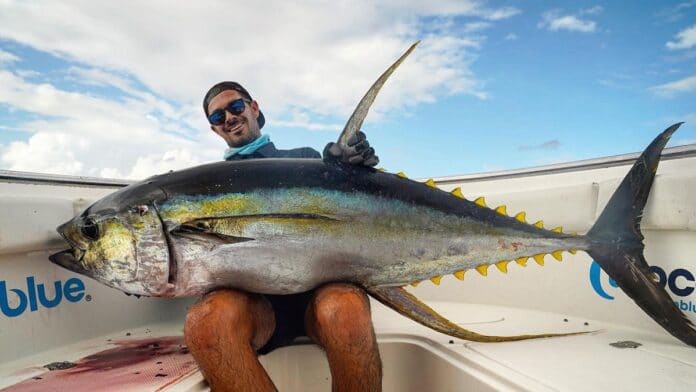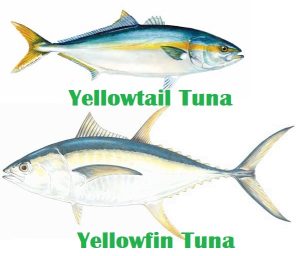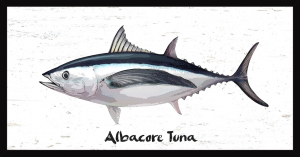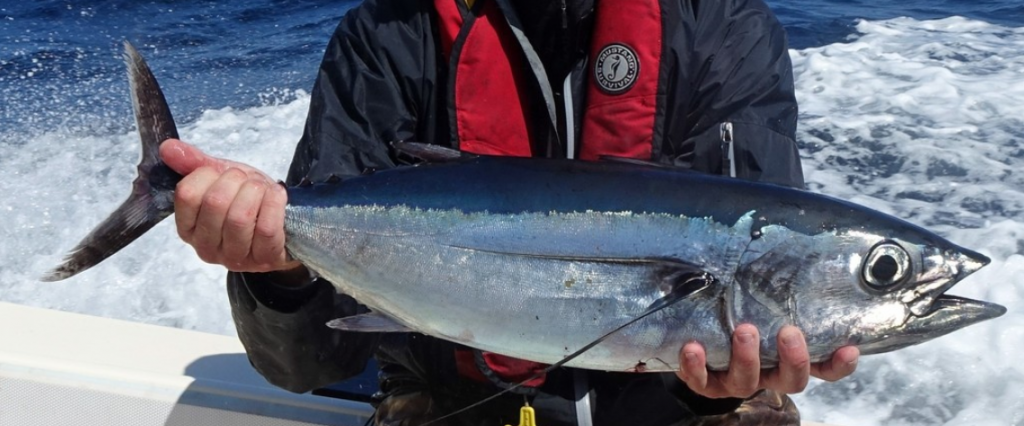
Yellowfin Tuna Fishing
Overview of Yellowfin Tuna Size
Yellowfin tuna (Thunnus albacares) is a large species of tuna, known for their impressive size and strength. These fish are a prized catch for both commercial and recreational fishermen. They are found in tropical and subtropical waters worldwide, where they thrive in the warm, nutrient-rich environments. Yellowfin tuna are easily recognized by their metallic blue backs, silver bellies, and long, bright yellow dorsal and anal fins.

Yellowfin Tuna Size
On average, yellowfin tuna weigh between 40 to 100 pounds (18 to 45 kg) and measure around 3 to 5 feet (0.9 to 1.5 meters) in length. However, these fish can grow much larger. Some yellowfin tuna have been recorded at over 400 pounds (180 kg) and can reach lengths of up to 6.5 feet (2 meters). The largest yellowfin tuna ever caught was 427 pounds, a record set in 2012.
Yellowfin Tuna Growth and Lifespan
Yellowfin tuna grow rapidly, which contributes to their large size. They can gain significant weight within just a few years. Their growth rate is influenced by factors like food availability, water temperature, and environmental conditions. These fish have a relatively short lifespan of about 5 to 8 years, but during this time, they reach full maturity quickly, which is one of the reasons why they can grow so large.
Regional Size Differences
The size of yellowfin tuna can vary depending on their location. In the Eastern Pacific, for example, yellowfin tend to be smaller on average compared to those found in the Western Pacific or the Indian Ocean. This variation is influenced by the availability of prey, water temperatures, and other environmental factors. In regions where food is abundant, yellowfin tuna grow faster and reach larger sizes.
Factors Affecting Size
Several factors influence the size of yellowfin tuna, including:
- Diet – Yellowfin tuna feed on a variety of prey, including smaller fish like sardines and mackerel, squid, and crustaceans. A diet rich in these prey species allows yellowfin tuna to grow quickly.
- Habitat – Warm, offshore waters with abundant food sources are ideal for yellowfin tuna growth. They are typically found in areas where ocean currents converge, creating upwellings that bring nutrients to the surface, supporting a rich food chain.
- Fishing Pressure – In heavily fished areas, yellowfin tuna may be smaller on average due to the removal of larger individuals from the population. Overfishing can lead to a decrease in the average size of the fish in a given region.
Importance of Size in Fishing
The size of yellowfin tuna is an important consideration for anglers. Larger yellowfin are more challenging to catch, requiring heavier tackle and more skill. They are also prized for their meat, which is used in sushi, sashimi, and other dishes. Anglers often target larger individuals, known as “cows,” which are highly sought after in the sportfishing community.
Fishing for large yellowfin tuna requires patience, strength, and the right equipment. These fish are known for their powerful runs and ability to fight for hours, testing the endurance of even the most experienced anglers.
Yellowfin Tuna Fishing
Best Locations for Yellowfin Tuna Fishing
Yellowfin tuna are found in warm offshore waters around the world. Some of the best locations for yellowfin tuna fishing include:
- Gulf of Mexico The warm waters of the Gulf of Mexico are a prime location for yellowfin tuna fishing. The area is known for producing large fish, particularly around the oil rigs and other structures where baitfish congregate.
- Hawaii Hawaii is another top destination for yellowfin tuna fishing. The waters around the islands are rich in marine life, providing plenty of food for yellowfin tuna to thrive. The “Ahi,” as they are known locally, are highly prized by both commercial and recreational fishermen.
- Caribbean The Caribbean Sea offers excellent opportunities for yellowfin tuna fishing. The warm, clear waters are home to large schools of yellowfin, particularly around the islands and along the continental shelf.
- Eastern Pacific The waters off the coast of Central and South America are also known for their yellowfin tuna populations. The Eastern Pacific is a productive fishing ground, with large schools of yellowfin tuna present year-round.
- Western Pacific The Western Pacific, particularly around Japan and the Philippines, is another hotspot for yellowfin tuna. The area is known for producing some of the largest yellowfin tuna in the world.
Best Times of Year for Yellowfin Tuna Fishing
Yellowfin tuna are typically caught year-round, but the best time to fish for them varies by location. In the Gulf of Mexico and the Caribbean, the peak season is from late spring to early fall. In Hawaii, yellowfin tuna can be caught year-round, with the best fishing from May to September. The Eastern and Western Pacific also offer year-round fishing opportunities, with peak seasons varying by region.
Yellowfin Fishing Equipment
Fishing for yellowfin tuna requires the right tackle and gear to handle these powerful fish. Key equipment includes:
- Rods and Reels Heavy-duty rods and reels are essential for yellowfin tuna fishing. A rod with a high line rating (50-100 lbs) and a strong reel with a high line capacity (500+ yards) are recommended. Conventional reels are preferred for their strength and ability to handle large fish.
- Line Braided line is commonly used for yellowfin tuna fishing because of its strength and low stretch. A line with a test strength of 50 to 100 pounds is recommended. Some anglers also use fluorocarbon leaders to increase their chances of a bite, as these are less visible in the water.
- Hooks and Lures Circle hooks are often used for yellowfin tuna fishing because they are less likely to be swallowed by the fish, resulting in a higher chance of a successful catch-and-release. Live bait, such as sardines or mackerel, is commonly used, but artificial lures, such as jigs and trolling lures, can also be effective.
- Gaff A strong gaff is essential for landing large yellowfin tuna. A gaff with a long handle and a sharp hook will help you secure the fish and bring it on board.
Yellowfin vs Yellowtail Tuna
Yellowfin and Yellowtail Tuna
Yellowfin Tuna (Thunnus albacares) and Yellowtail Tuna (Seriola lalandi) are often confused due to their similar names and appearance. However, they are different species with distinct characteristics. Understanding the differences between these two fish can help anglers target the right species and appreciate the unique qualities of each.
Difference Between Yellowfin and Yellowtail Tuna
Yellowfin tuna are larger and more robust compared to yellowtail tuna. They have a streamlined, torpedo-shaped body with a metallic blue-black back and silver belly. The most distinctive feature of yellowfin tuna is their long, bright yellow dorsal and anal fins, which can extend past the tail fin. These fins give the yellowfin its name and are a key characteristic for identification.
Yellowtail tuna, on the other hand, have a more slender, elongated body. Their coloration is slightly different, with a dark blue or greenish back and a silver belly. The yellowtail’s dorsal and anal fins are shorter and located closer to the belly. Yellowtail also have a prominent yellow stripe running along their sides from the gills to the tail, which gives them their name.
Yellowfin and Yellowtail Size Comparison
Yellowfin tuna are generally larger than yellowtail tuna. Yellowfin can grow up to 6.5 feet (2 meters) in length and weigh over 400 pounds (180 kg), with some reaching up to 440 pounds (200 kg). Yellowtail tuna, however, are typically smaller, with an average size of 20 to 40 pounds (9 to 18 kg) and a maximum size of around 110 pounds (50 kg).
Habitat and Distribution
Yellowfin tuna are found in tropical and subtropical waters worldwide. They are pelagic fish, meaning they live in the open ocean, often far from shore. Yellowfin are typically found in warm waters, where they form large schools and are often associated with dolphins, birds, and other marine life.
Yellowtail tuna, also known as California yellowtail or kingfish, are primarily found in the Pacific Ocean, particularly around Japan, Australia, and the west coast of North America. They prefer cooler, temperate waters and are often found near reefs, rocky outcroppings, and kelp forests. Yellowtail are also known to form schools, particularly around offshore structures and underwater features.
Flavor and Culinary Uses
Both yellowfin and yellowtail tuna are prized for their culinary qualities, but they have different flavors and textures.
- Yellowfin Tuna Yellowfin tuna has a firm, meaty texture and a rich, strong flavor. It is often used in sushi and sashimi, where its deep red flesh is highly valued. Yellowfin is also popular for grilling, searing, and making poke. The high-fat content in the belly meat, known as “otoro,” is particularly prized for its buttery texture and intense flavor.
- Yellowtail Tuna Yellowtail tuna has a milder flavor and a softer, more delicate texture compared to yellowfin. It is commonly used in Japanese cuisine, particularly for sashimi and sushi. Yellowtail is also excellent when grilled or broiled, as its fat content helps keep the flesh moist and flavorful. The flesh is lighter in color, ranging from pale pink to white, and is often marinated in soy sauce or other seasonings to enhance its flavor.
Fishing for Yellowfin and Yellowtail Tuna
The techniques used to catch yellowfin and yellowtail tuna are similar but tailored to their different habitats and behaviors.
- Yellowfin Tuna As mentioned earlier, trolling, chunking, jigging, and live baiting are effective methods for catching yellowfin tuna. These fish are often found in deep, open waters, so anglers typically use heavy tackle and large lures or live bait to target them.
- Yellowtail Tuna Yellowtail tuna are often caught using live bait, such as sardines or mackerel, fished near rocky outcroppings, reefs, or offshore structures. Jigging and trolling can also be effective, particularly when yellowtail are schooling near the surface. Lighter tackle is often used for yellowtail, as they are smaller and less powerful than yellowfin tuna.
FAQs for Yellowfin and Yellowtail Tuna
What is the best bait for yellowfin tuna?
The best bait for yellowfin tuna depends on the fishing method. Live bait such as sardines, mackerel, and squid are highly effective. For trolling, lures like cedar plugs and skirted lures work well. Matching the hatch, using bait that mimics the local prey species is key to success.
What is the best time of year to catch yellowfin tuna?
Yellowfin tuna can be caught year-round, but the best time varies by location. In the Gulf of Mexico, the peak season is from late spring to early fall. In Hawaii, the best fishing is from May to September. Check local fishing reports for the most accurate timing in your area.
How do I distinguish between yellowfin and yellowtail tuna?
Yellowfin tuna have long, bright yellow dorsal and anal fins, a metallic blue-black back, and a silver belly. They are larger and more robust. Yellowtail tuna have shorter yellow fins located closer to the belly and a prominent yellow stripe running along their sides. They are generally smaller and have a more slender body.
Biggest yellowfin tuna ever caught?
The largest yellowfin tuna on record weighed 427 pounds and was caught off the coast of Mexico in 2012. This record-setting fish was caught by angler Guy Yocom using a live bait rig.
Is yellowfin tuna good to eat?
Yes, yellowfin tuna is highly prized for its taste and texture. It is commonly used in sushi, sashimi, poke, and grilled dishes. The meat is firm, flavorful, and rich in healthy omega-3 fatty acids.
Where are the best places to fish for yellowfin tuna?
Top locations for yellowfin tuna fishing include the Gulf of Mexico, Hawaii, the Caribbean, the Eastern Pacific, and the Western Pacific. These regions offer warm, offshore waters rich in marine life, providing ideal conditions for yellowfin tuna.
How long do yellowfin tuna live?
Yellowfin tuna have a relatively short lifespan, typically living between 5 to 8 years. Despite their short lives, they grow rapidly and reach maturity within a few years.
What is the difference between yellowfin tuna and albacore tuna?
Yellowfin tuna are larger and have a firmer, richer-flavored meat compared to albacore tuna, which is smaller and has a lighter, milder flavor. Albacore is often used for canned tuna, while yellowfin is more commonly used in fresh preparations like sushi and sashimi.
Check out other species of tuna.



 Penn Tuna Fishing Rod & Reel Combo
Penn Tuna Fishing Rod & Reel Combo Fishing Pliers and Knife Combo
Fishing Pliers and Knife Combo View Best Tuna Fishing Lures
View Best Tuna Fishing Lures